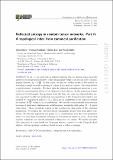| dc.contributor.author | Akers, Chris | |
| dc.contributor.author | Faulkner, Thomas | |
| dc.contributor.author | Lin, Simon | |
| dc.contributor.author | Rath, Pratik | |
| dc.date.accessioned | 2023-01-17T13:15:53Z | |
| dc.date.available | 2023-01-17T13:15:53Z | |
| dc.date.issued | 2023-01-13 | |
| dc.identifier.uri | https://hdl.handle.net/1721.1/147110 | |
| dc.description.abstract | Abstract
In ref. [1], we analyzed the reflected entropy (SR) in random tensor networks motivated by its proposed duality to the entanglement wedge cross section (EW) in holographic theories,
S
R
=
2
EW
4
G
$$ {S}_R=2\frac{EW}{4G} $$
. In this paper, we discover further details of this duality by analyzing a simple network consisting of a chain of two random tensors. This setup models a multiboundary wormhole. We show that the reflected entanglement spectrum is controlled by representation theory of the Temperley-Lieb algebra. In the semiclassical limit motivated by holography, the spectrum takes the form of a sum over superselection sectors associated to different irreducible representations of the Temperley-Lieb algebra and labelled by a topological index k ∈ ℤ>0. Each sector contributes to the reflected entropy an amount
2
k
EW
4
G
$$ 2k\frac{EW}{4G} $$
weighted by its probability. We provide a gravitational interpretation in terms of fixed-area, higher-genus multiboundary wormholes with genus 2k – 1 initial value slices. These wormholes appear in the gravitational description of the canonical purification. We confirm the reflected entropy holographic duality away from phase transitions. We also find important non-perturbative contributions from the novel geometries with k ≥ 2 near phase transitions, resolving the discontinuous transition in SR. Along with analytic arguments, we provide numerical evidence for our results. We finally speculate that signatures of a non-trivial von Neumann algebra, connected to the Temperley-Lieb algebra, will emerge from a modular flowed version of reflected entropy. | en_US |
| dc.publisher | Springer Berlin Heidelberg | en_US |
| dc.relation.isversionof | https://doi.org/10.1007/JHEP01(2023)067 | en_US |
| dc.rights | Creative Commons Attribution | en_US |
| dc.rights.uri | https://creativecommons.org/licenses/by/4.0/ | en_US |
| dc.source | Springer Berlin Heidelberg | en_US |
| dc.title | Reflected entropy in random tensor networks. Part II. A topological index from canonical purification | en_US |
| dc.type | Article | en_US |
| dc.identifier.citation | Journal of High Energy Physics. 2023 Jan 13;2023(1):67 | en_US |
| dc.contributor.department | Massachusetts Institute of Technology. Center for Theoretical Physics | |
| dc.identifier.mitlicense | PUBLISHER_CC | |
| dc.eprint.version | Final published version | en_US |
| dc.type.uri | http://purl.org/eprint/type/JournalArticle | en_US |
| eprint.status | http://purl.org/eprint/status/PeerReviewed | en_US |
| dc.date.updated | 2023-01-15T04:10:36Z | |
| dc.language.rfc3066 | en | |
| dc.rights.holder | The Author(s) | |
| dspace.embargo.terms | N | |
| dspace.date.submission | 2023-01-15T04:10:36Z | |
| mit.license | PUBLISHER_CC | |
| mit.metadata.status | Authority Work and Publication Information Needed | en_US |
